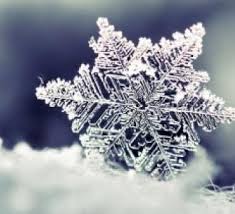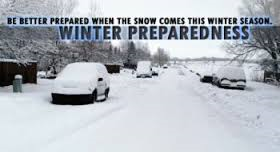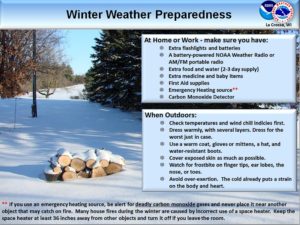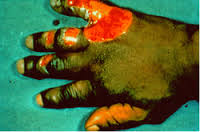
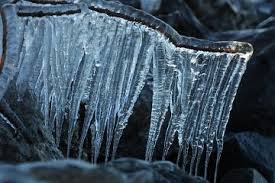
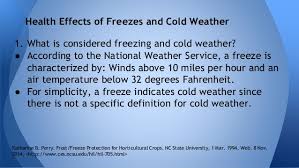
There are workers and people at home working around the house outside who are exposed to extreme cold or work in cold environments for a long period of time may be at risk of cold stress. Extreme cold weather is a dangerous situation that can bring on health emergencies in susceptible people, such as those without shelter, outdoor workers, and those who work in an area that is poorly insulated or without heat. What constitutes cold stress and its effects can vary across different areas of the country. In regions relatively unaccustomed to winter weather, near freezing temperatures are considered factors for “cold stress.” Whenever temperatures drop decidedly below normal and as wind speed increases, heat can more rapidly leave your body. These weather-related conditions may lead to serious health problems.
When exposed to cold temperatures, your body begins to lose heat faster than it can be produced. Prolonged exposure to cold will eventually use up your body’s stored energy. The result is hypothermia, or abnormally low body temperature. A body temperature that is too low affects the brain, making the victim unable to think clearly or move well. This makes hypothermia particularly dangerous because a person may not know it is happening and will not be able to do anything about it.
The symptoms you see with this hypothermia (body exposed to freezing temperatures) are: SHIVERING, LOSS OF COORDINATION, FATIGUE, CONFUSION OR DISORIENTATION.
When the hypothermia gets severe the symptoms go to NO SHIVERING, BLUE SKIN (CYANOTIC), DILATED PUPILS, SLOWED PULSE AND BREATHING, AND LOSS OF CONCIOUSNESS.
Another problem secondary to cold weather is cold water immersion creates a specific condition known as immersion hypothermia. It develops much more quickly than standard hypothermia because water conducts heat away from the body 25 times faster than air. Typically people in temperate climates don’t consider themselves at risk from hypothermia in the water, but hypothermia can occur in any water temperature below 70°F. Survival times can be lengthened by wearing proper clothing (wool and synthetics and not cotton), using a personal flotation device (PFD, life vest, immersion suit, dry suit), and having a means of both signaling rescuers (strobe lights, personal locator beacon, whistles, flares, waterproof radio) and having a means of being retrieved from the water. Below you will find links with information about cold water survival and cold water rescue.
- NIOSH Commercial Fishing Safety Topic Page
- Alaska Marine Safety Education Association
- Minnesota Sea Grant
Another problem due to cold weather is frostbite is an injury to the body that is caused by freezing. Frostbite causes a loss of feeling and color in the affected areas. It most often affects the nose, ears, cheeks, chin, fingers, or toes. Frostbite can permanently damage body tissues, and severe cases can lead to amputation. In extremely cold temperatures, the risk of frostbite is increased in workers with reduced blood circulation and among workers who are not dressed properly. Signs or symptoms of frostbite are reduced blood flow to hands and feet (fingers or toes can freeze), Reduced blood flow to hands and feet (fingers or toes can freeze, numbness, tingling or stinging, aching, pale to blue and even waxy skin.
Another problem from long exposure to cold that can arise is trench foot, also known as immersion foot, is an injury of the feet resulting from prolonged exposure to wet and cold conditions. Trench foot can occur at temperatures as high as 60 degrees F if the feet are constantly wet. Injury occurs because wet feet lose heat 25-times faster than dry feet. Therefore, to prevent heat loss, the body constricts blood vessels to shut down circulation in the feet. Skin tissue begins to die because of lack of oxygen and nutrients and due to the buildup of toxic products.
Symptoms of trench foot include: Reddening of the skin, Numbness, Leg cramps, Swelling, Tingling pain, Blisters or ulcers, Bleeding under the skin, and Gangrene (the foot may turn dark purple, blue, or gray).
Ideas to try to prevent long exposure to cold problems from happening are:
- Wear appropriate clothing. Tight clothing reduces blood circulation. Warm blood needs to be circulated to the extremities.
- When choosing clothing, be aware that some clothing may restrict movement resulting in a hazardous situation.
- Wear several layers of loose clothing. Layering provides better insulation.
- Make sure to protect the ears, face, hands and feet in extremely cold weather. Wear a hat; it will keep your whole body warmer. (Hats reduce the amount of body heat that escapes from the head).
- Boots should be waterproof and insulated.
- Move into warm locations during work breaks; limit the amount of time outside on extremely cold days.
- Carry cold weather gear, such as extra socks, gloves, hats, jacket, blankets, a change of clothes and a thermos of hot liquid.
- Include a thermometer and chemical hot packs in your first aid kit.
- Avoid touching cold metal surfaces with bare skin.
Monitor your physical condition whenever you go outside in the cold and prepare properly for that weather.




